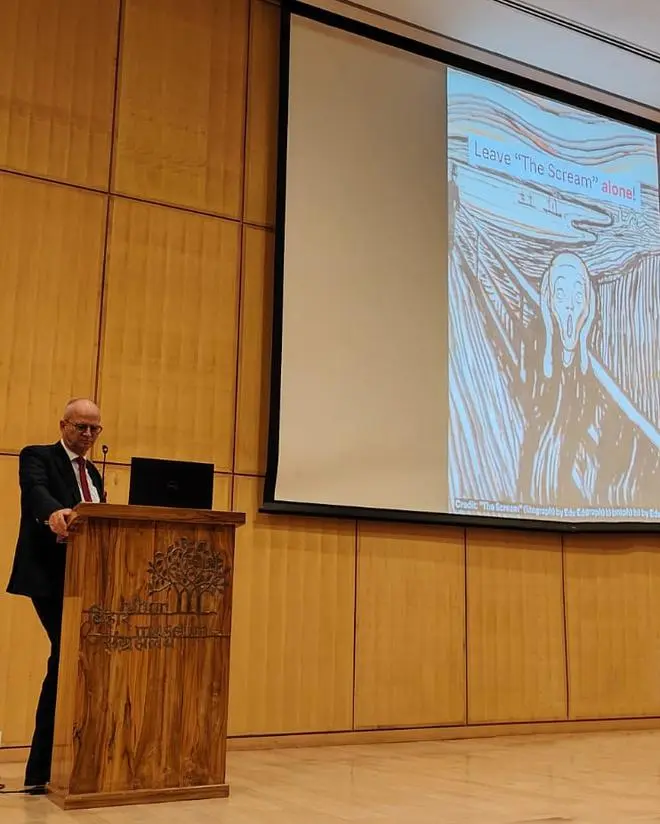Think museums and most people would imagine stuffy, academic places where the past is recreated and presented, and where the young would go only unwillingly. But museums can become thriving, throbbing experiential hubs — and a great place for brands and businesses to create engaging touchpoints with customers.
At the Bihar Museum Biennale 2023, a four-month long event in Patna that launched this August, where museum directors, gallery owners and art lovers converged, there was a scintillating discussion on the creative business of museums. How can museums increase their footfalls? How can museums make their displays get into the current contemporary culture and sensibilities? How can museums attract children and young adults, and help them develop innovative minds?
The Creative Business of Museums
The venue of the Biennale — the Bihar Museum itself, a striking modern space built by Japanese architectural firm Maki & Associates, in association with, Mumbai-based Opolis Associates, on a sprawling 5.6 hectares site, proved to be an excellent example of a highly experiential cultural gallery. For instance, dancers and singers from Kilkari Bal Bhawan bring alive the artefacts in the museum through songs and performances. Interactive touchscreens with quizzes about various items on display — for instance the first currency in India, which incidentally came from Bihar — engage the visitors. A fine dining restaurant, the well known Pot Belly brand, a cafeteria and a large shop ensure the visitor stays longer at the museum and spends more.
But it was during the Biennale symposium where the likes of Professor Yannick Lintz, President of the Guimet National Museum, Paris, Dr Pheroza Godrej, founder of Cymroza Art Gallery, Mumbai, Stephen Inglis, former director general at the Canadian Museum of Civilizations and Michael Peter Edson, the former New Media strategist for the Smithsonian Institute, who is now setting up the museum of solutions in Mumbai funded by the JSW Foundation, spoke that ideas flew.
Here are some takeaways.
Past becomes contemporary
Norwegian ambassador to India, Hans Jacob Frydenlund, kicked off the discussions on the creative business of museums by talking about Norway’s most iconic painting — The Scream. He described how it has inspired a movie franchise and how the agonised face in the painting has also inspired an emoji. “All museums have a story to tell and all museums need a professional to tell the story,” said Frydenlund.

Norwegian ambassador to India, Hans Jacob Frydenlund on Norway’s most iconic painting — The Scream.
Interestingly, enough The Scream was also featured in Coca-Cola’s global campaign titled Masterpiece. The scintillating ad which uses AI and special effects shows a bored art student in a museum, until there is sudden action. A bottle of Coca-Cola jumps from canvas to canvas, starting with Andy Warhol’s 1962 Coca-Cola painting onto Turner’s The Shipwreck, Edvard Munch’s The Scream and several other masterpieces before it finally lands into Vermeer’s Girl with a Pearl Earring, whose subject opens the bottle and passes it to the bored student for inspiration.
Any object can become a museum piece
Dr Alka Pande, art historian and curator of the Bihar Museum Biennale showed a series of slides of off-beat museums around the world to show that any object can become a museum piece. For instance, in Japan, there is the Cup Noodles museum set up by Nissin. Later, chatting with this writer, Pande said that business houses in India that spend huge amounts on advertising could create great connect and resonance by setting up museums on everyday items. For instance, Amul could do a history of dairy museum or Haldiram could create a museum revolving around the history of street foods.

Cup Noodles Museum in Japan
Involving the communities
Michael Edson talked about how the Museum of Solutions (MuSo) in Mumbai is going to be boldly child-led. “Young people have tremendous imagination and energy. But they don’t become magically mature,” he said, explaining the importance of spaces that would fuel curiosity and thinking, and spark innovation. The MuSo will have no collections, he promised. It would also involve the communities and take ideas from them.
Merchandise and more
Museums are slow to change, rued Edson. In India especially, this is true, said Alka Pande, describing how museums can do so much by creating exciting merchandise the way several museums abroad do. Roping in celebrities can help boost footfalls too. For instance, the Louvre in Paris broke all ticket-office records soon after Beyonce and Jay Z’s music video was shot there.
(This writer visited Patna at the invitation of the Bihar Museum Biennaleorganisers)







Comments
Comments have to be in English, and in full sentences. They cannot be abusive or personal. Please abide by our community guidelines for posting your comments.
We have migrated to a new commenting platform. If you are already a registered user of TheHindu Businessline and logged in, you may continue to engage with our articles. If you do not have an account please register and login to post comments. Users can access their older comments by logging into their accounts on Vuukle.